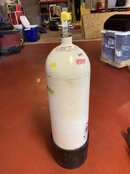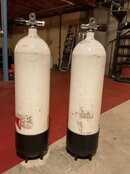I see too many people think of new painted tanks as being as precious as a new car paint job and they can't stand the thought of them with one mark, ding, or chip. Some people are show car fanatical.
To me tanks are more of a work truck or equipment trailer, they are meant to be worked and used.
After a few years if there are chips and scratches just brush touch them. The bigger worry is internal rust by somebody's wet fill or crappy compressor.
Externally, the bigger worry is rust forming under a boot. Always remove the boot periodically and make sure no rust bubbles are forming. If there are rust blisters pop them and flake out the bad area until you reach solid paint. All a blister will do is hold salt water and accelerate the corrosion process. The worst thing you can do is be scared to pop it and just leave it alone to form a deeper pit just because you don't want a blemish on your painted tank.
I'd rather dive a beat up tank with character than a pristine brand new tank anyway.
I used to be in the auto body industry, I know how people think.





